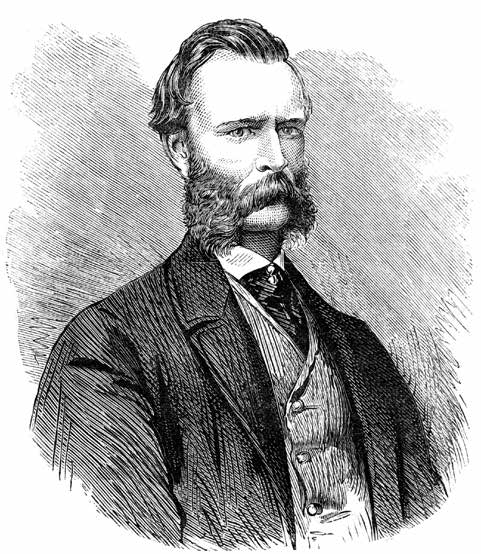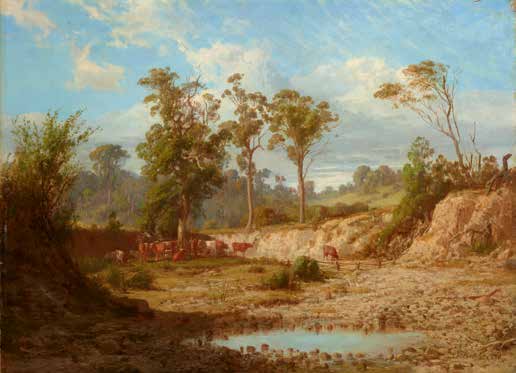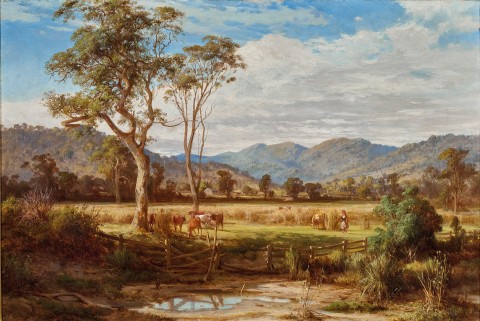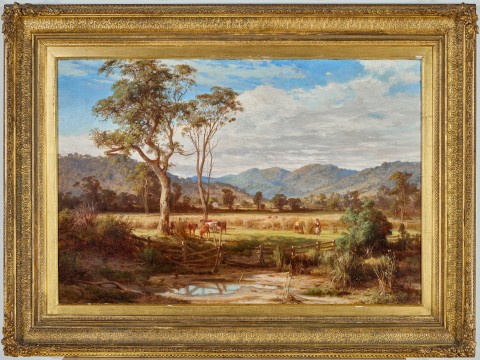BACCHUS MARSH PASTURE, 1876
LOUIS BUVELOT
oil on canvas
58.0 x 86.5 cm
signed and dated lower left: Ls Buvelot. 1876
bears inscription on frame verso: L Buvelot. N1
framer's label attached verso: Isaac Whitehead Carver & Gilder
Hon. J. A. MacPherson, Victoria, acquired directly from the artist in 1876
Thence by descent
Private collection, United Kingdom
Private collection, Sydney, acquired from the above in 2021
The Argus, Melbourne, 31 July 1876, p. 4
Gray, J., Louis Buvelot: his life and work, Masters Research thesis [unpublished], VCA – School of Art, The University of Melbourne, 1977, ‘Miss Ellen Frey’s list of works [alphabetical, by title] and owners, 1904’, vol. 2, cat. 6 (as ‘Bacchus Marsh Pasture, Hon J Macpherson’)
1 BUVELOT.jpg

‘M. Buvelot has just completed for the Chief Secretary, an oil painting representing a quiet landscape at Bacchus Marsh. The features of the landscape are very simple, and but for the two white gum trees, which occupy a prominent position in the foreground, the scene might be mistaken for an English one. An amphitheatre of low wooded, and softly rounded hills encloses a verdant arena, in which a rich crop of thistles bears a not indistinct resemblance to a field of standing corn. A waterhole set in a green framework of scrub, lights up the picture pleasantly, and reflects the sheen of the summer sky, and while the tone of the picture is bright and sunny, the sentiment it breathes is one of perfect repose.’1
Within a few years of his arrival in Melbourne in 1865, aged fifty-one, Swiss-born Louis Buvelot was the most admired landscape artist working in the colony of Victoria, superseding his predecessor Eugene von Guérard, the elder by four years. In contrast to von Guérard’s carefully rendered (or to some, ‘laborious’) depictions of pastoral properties and awe-inspiring remote scenery, Buvelot was praised for being ‘disdainful of tedious detail… With the dry bed of a creek, some ragged scrub, a patch of verdure, and the rugged stem of an old gum tree he succeeds in constructing a picture which you can return to again and again with pleasure’.2 By 1870, three substantial landscapes by Buvelot had been acquired for the newly formed National Gallery of Victoria. Although von Guérard was appointed painting master for the Gallery School over Buvelot, it was Buvelot’s more fluid approach that had the greater impact among his contemporaries and successors. Arthur Streeton, Frederick McCubbin and Tom Roberts came to regard him as ‘the father of Australian landscape painting’, McCubbin stating that ‘there was no one before him to point out the way; he possessed, therefore in himself the genius to catch and understand the salient living features of this country’.3
Buvelot first visited and began sketching the waterways, floodplains, cleared paddocks and forested hills around the small township of Bacchus Marsh, set between the Lerderderg and Werribee rivers, in autumn 1876. Although he did not paint en plein air, the numerous pencil sketches he drew – helpfully dated and titled – were the source for several oil paintings completed later that year in his Fitzroy studio. These included two views of Goodman’s Creek (Art Gallery of New South Wales, University of Melbourne) and a watercolour of the nearby Pentland Hills (Art Gallery of New South Wales), which was translated into a chromolithograph gifted to subscribers to the Art Union of Victoria.4 Buvelot was also painting to commission: one scene of Bacchus Marsh was produced for local art collector Thomas Welton Stanford, praised by a reviewer as ‘a perfect gem… the best work that has yet emanated from M. Buvelot’s studio’.5 Two months later, Bacchus Marsh pasture, 1876 was similarly praised in the media, painted on commission for John Alexander MacPherson.6
1 BUVELOT 2.jpg

Not enough is yet known about MacPherson as a collector. Born into a pastoral family, and trained as a lawyer, he was elected to the Victorian Parliament in 1864, serving briefly as the seventh Premier of the colony (September 1869 – April 1870). Notably it was during these months that the new Public Library, Museums and National Gallery of Victoria Act was passed and MacPherson and several of his ministers were appointed trustees, a position he held until 1880. As discussed in lot 14, he was known to be acquiring art as early as 1870, and in 1876, while serving as Chief Secretary, MacPherson commissioned at least two paintings: a dramatic mountainous Gippsland view from von Guérard (now Kerry Stokes Collection, Perth),7 and this, a distinct contrast in its tranquillity and benign rusticity, the young woman tending the cows akin to a peasant in Dutch landscapes of the seventeenth century. Bacchus Marsh pasture remained with MacPherson’s descendants until recently. It is housed in its original gilt frame, demonstrating the best-known style of the pre-eminent Melbourne frame maker Isaac Whitehead.8
Buvelot’s declining eyesight prevented him from painting in his last years. He died in May 1888 and was buried in Kew Cemetery: a publicly funded monument was later erected. Only two months after his death, the National Gallery of Victoria held a commemorative retrospective, the first such exhibition of an ‘Australian’ artist.9 Few recall his early, successful career in Brazil (1835 – 52), almost equal in years to his working career in Australia but without the posthumous and continuing praise and recognition.
1. The Argus, Melbourne, 31 July 1876, p. 4
2. ‘The Exhibition of the Victorian Academy of Arts’, The Argus, Melbourne, 1 December 1870, p. 7
The von Guérard quote above is also from this review.
3. McCubbin cited in The Art of Frederick McCubbin, The Lothian Book Publishing Co., Melbourne, 1916, p. 85.
4. Summer evening in the Pentland Hills, 1876, chromolithograph, various collections.
5. ‘News of the day’, The Age, Melbourne, 18 May 1876, p.3. Stanford is briefly discussed in Gerard Vaughan’s ‘Art collectors in colonial Victoria 1854 – 1892: An analysis of taste and patronage’, University of Melbourne, BA Hon. thesis, 1976, pp. 16, 44 – 45. MacPherson is not mentioned.
6. Miss Frey, executor of Madame Buvelot’s estate, titled Stanford’s painting Bacchus Marsh, stream and this Bacchus Marsh, pasture, in her list L’oeuvre australienne de Louis Buvelot de Morge, 1905. See Jocelyn Gray, ‘Louis Buvelot: his life and work’, Victoria College of the Arts (University of Melbourne) MA thesis, 1977, vol. 2, n.p.
7. The Argus, Melbourne, 24 July 1876, p. 5
8. Holly McGowan-Jackson and Jessica Lehmann, ‘Framers in focus: Isaac Whitehead’, 26 July 2021, see: https://www.ngv.vic.gov.au/essay/framers-in-focus-isaac-whitehead
9. One of the Gallery’s rooms (now State Library Victoria) was named the Buvelot Gallery.
ALISA BUNBURY

